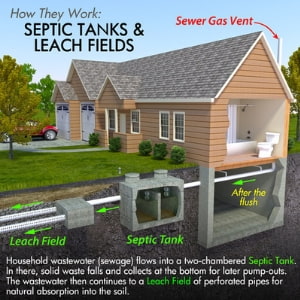
Food for thought: there are still areas of the world that do not use indoor plumbing and have what we would consider ‘ancient’ waste removal systems. This can mean that untreated sewage ends up in ditches or even the street.
Luckily, for us, our indoor plumbing has advanced sewage systems, and a simple pull of a lever will remove waste from the toilet. Also, the tap water that flows from faucets is drained to… wait, where does it drain to? If you don’t know the answer, it’s okay–most people don’t.
Most people don’t even think about where their solid waste and wastewater ends up nor how it is cleaned. We’re going to take a look at the two most popular ways to remove waste from the home and how they work to clean the water. Keep reading for more information!
A Quick Look at Septic Tanks

Once sewage reaches a septic tank, it will naturally separate: solids sink to the bottom, forming sludge while fats and oils rise to the top to form scum.
Relatively clear water is left in the middle of these two layers. As more sewage is added to the tank, the water leaches out into a drain field.
The drain field is comprised of punctured pipes that allows the surrounding soil to clean the water of nitrogen and phosphorus. At this point, the water is safe and is naturally recycled.
Sewer Systems Aren’t Terribly Complicated

Once at the facility, the sewage may be treated up to three times. The first stage of treatment basically functions as a giant septic tank.
This giant septic tank removes up to 50% of contaminants from the sewage and the water can either be treated with chlorine or move to stage two of treatment. Stage two involves using bacteria to eat away at up to 90% of contaminants.
If there is no stage three, the water is then treated with chlorine and discharged. If there is a stage three of treatment, the water is chemically treated to remove nitrogen, phosphorus, and any minute levels of contaminants. Sometimes filter beds may also be used in this stage of treatment.
No matter the number of stages of treatment you shouldn’t worry about the safety of the water that is recycled–it is generally safe but may have more or less of a (safe) chemical taste or smell.
Considerations For Other Types of Waste Disposal

A cesspool basically holds all household waste, while the water is percolated and released into the surroundings. This tank must be often pumped to remove the waste which adds to the cost.
Another option of waste disposal is composting toilets. These toilets and the systems they run on allow for water to evaporate and solid waste to be composted into fertilizer. They are quite eco-friendly but are not functional for all households.
If you’ve learned a thing or two about where your waste goes, share this article with friends–and if you’re having problems with anything related to plumbing or drain cleaning, give Ben Franklin Plumbing a call!













